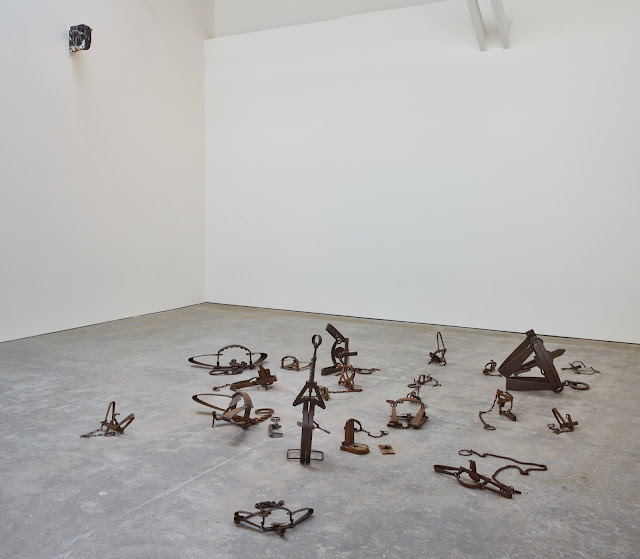
|
| Charlotte Posenenske: Series D Square Tubes Photo: Johnna Arnold |
| Mechanisms on view at The Wattis Institute through Feb. 24, 2018 |
test[s] existing systems with inefficient mechanisms, impossible tools, and elaborate protocols that misalign outputs from their inputs.
A precursor of the show was Pontus Hultén's memorable (and Walter Benjamin-haunted) The Machine at the End of the Mechanical Age, which the lamented Henry Hopkins brought to the old San Francisco Museum of Art fifty years ago. That show, though, pondered machines, while this one ponders mechanism: the workings of machinery, whether physical machinery of substance or metaphorical machinery of concept.
(Mechanism:machine :: mind:brain)
Another ghost haunting the Wattis Instituter: Marcel Duchamp. At every turn. On entering, Charlotte Posenenske's marvelous make-to-order sculptures assembled by gallery staff, from industrial ductwork, to Posenenske's instructions. They immediately recall Duchamp's Pulled at Four Pins and Malic Molds, which I believe were inspired by Duchamp's amused liking for sheet metal installations of various kinds, particularly rooftop installations.
(Of course I'm influenced by personal biography: my father was a sheet metal worker; I grew up smelling muriatic acid and solder and contemplating, fascinated, the emergence of three-dimensional forms from two-dimensional sheets of tinplate.)
Pushing the mind-body metaphor, Posenenske's duct-sculptured is inescapably figurative. The pathetic fallacy of the Industrial Age is the equivalence of mankind and machine. Fallacy has always its humorous side, the humor of absurd inevitability; Posenenske's work is the perfect introduction to the show.
 |
| Danh Vo: Twenty- two Traps Photo: Johnna Arnold |
Has Mechanisms trapped you yet? Then perhaps it's time to consider the beautiful, pristine, contemplative, dedicated and disciplined work of the late Jay De Feo: a series of her inimitable mixed-media drawings on one wall, an installation of a grid of Xerox manipulations on another. In general De Feo worked from a real and ordinary object (a familiar readymade?), utterly divorcing it from its usual context, considering it as a three-dimensional thing valuable, for the moment, for her, as a bearer of form, defined by the curves and sheen of its surface, and above all a challenge (always successfully met) to the expressive ability of her hand and arm.
You see this in the mixed-media drawings, of course, whose beauty and truth led me to this installation in the first place; but also in the wonderful Xerox manipulations which, again, reduce three dimensions to two, another challenge to the mind's comprehension of what the eye sees.
 |
| Louise Lawler: Formica (adjusted to fit, distorted for the times, slippery slope 1) Photo: Johnna Arnold |
(It should be noted that the subjects of Lawler's photographs are themselves works of art, photographed as they are installed in galleries, that their display in other settings will be a kind of transplanting, thus a function within a cultural and societal mechanism.)
Another side of De Feo's example is explored in the elegant small sculptures of Zarouhie Abdalian, who chooses small metal hand tools, refines and nickel-plates them, and then assembles them into compositions without in any way attaching them to one another. You're forgiven for recalling a chance encounter of a sewing machine and an umbrella on an operating table. If you bump the sculpture stand (please don't) the assemblage is likely to fall apart and gallery staff will have to reassemble it (recalling their assembly, though with bolts and nuts, of the sections of Posenenske's ductwork). Another trap.
There seem to be endless discoveries in this installation. One more: Aaron Flint Jamison's Greaser, a slab of purpleheart (hardwood) formed of invisibly joined pieces, nearly twelve feet tall and perhaps half an inch thick, with a machine attached to its midsection causing it to vibrate nervously to a resonant frequency. The elegance of anxiety, or of excitation.
Mechanisms is accompanied by a catalog whose abstraction and intricacy requires more concentrated attention than I have had time to give until now; I hope to remedy this. There is also an extremely helpful guide to the exhibition with floor plans and detailed descriptions. The entire affair — exhibition, concept, catalog, individual works — can be exhausting, invigorating, meaningful, or overwhelming, depending on your mood and state of mind. So are we ever victims of our surroundings.
•CCA Wattis Institute for Contemporary Arts, 360 Kansas Street, San Francisco; (415) 355-9670
No comments:
Post a Comment